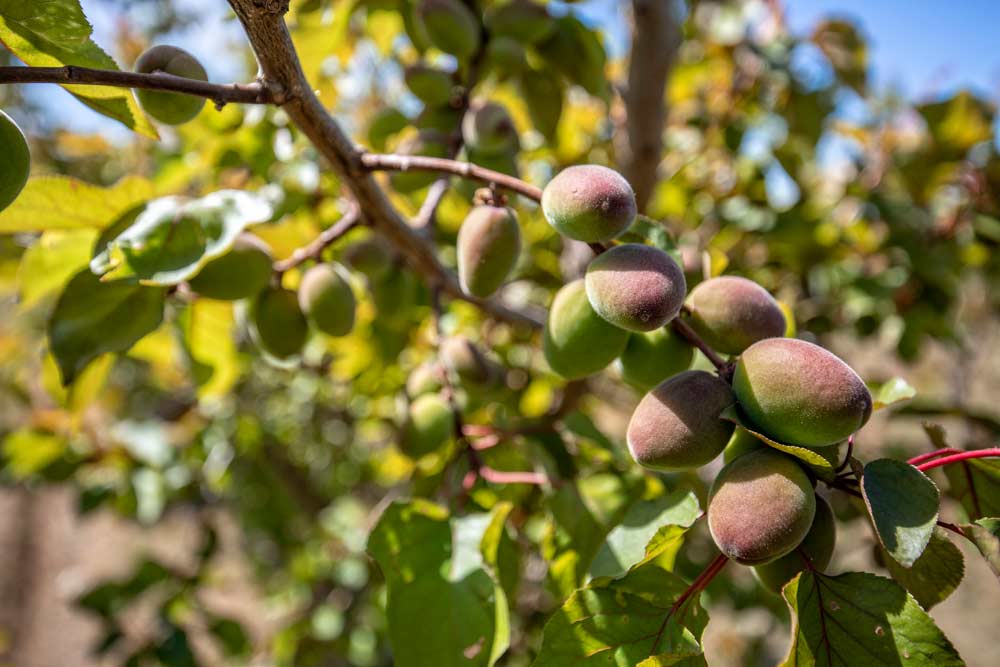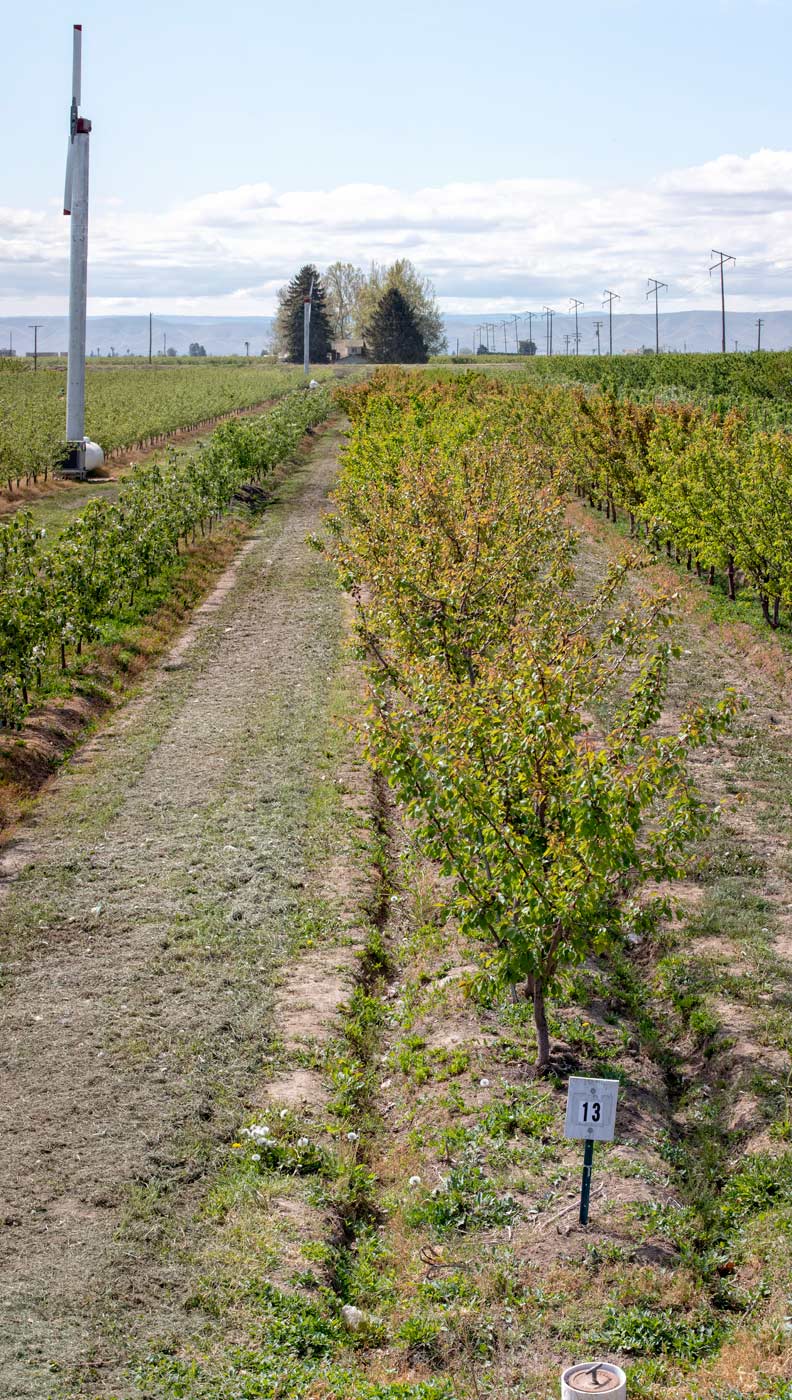
An unnamed selection of apricot developed by a now-defunct Canadian breeding program develops a strong red blush as it grows in a variety trial at Brandt’s Fruit Trees in Wapato, Washington. A few years ago, researchers at the Vineland Research and Innovation Centre in Ontario discovered more than a dozen promising selections in an ignored orchard block and put them back on track for commercialization in partnership with Brandt’s. (TJ Mullinax/Good Fruit Grower)
Ignored for decades after the breeding program shut down, several recently rediscovered Canadian apricots show promise for growers looking for large, flavorful fruit to revitalize the market.
“The stage two trees were planted over 20 years ago, and they kind of just sat around until the Vineland Research and Innovation Centre took over management of the genetics in 2014,” said Michael Kauzlaric, Vineland’s technology scout and grower outreach coordinator. “People just ate the fruit but didn’t evaluate them.”
A few years ago, when researchers decided to evaluate the apricots, they found some strong performance when it came to fruit quality, high tolerance to bacterial spot, and a nice spread of harvest dates in the trees bred by the now-defunct Agriculture and AgriFood Canada Harrow breeding program. So Vineland launched a new effort to find the best selections for Ontario’s growers and the global market.
“Some of these Vineland apricots get to 20 or 21 Brix. That’s something that gets your attention,” said Kevin Brandt of Brandt’s Fruit Trees, which is working with the Vineland Centre to test and commercialize new varieties of stone fruit and pears in the U.S. “They’ve got good texture, they are juicy, not mealy and they have a good flavor.”
At Brandt’s trial orchard in Wapato, Washington, about 15 Vineland varieties have been planted as part of an apricot variety trial, with about 50 selections from other breeding programs. This will be the third year for harvest, and Brandt said that based on their criteria, a couple of Vineland selections really stand out.
“First thing first, they have to size,” Brandt said. Then, timing is key, as growers need a steady pace of harvests. “After that, it’s all flavor.”
Ontario growers have their first chance to plant some of the most promising new selections this year, but only growers within the region’s plum pox quarantine can plant now.
The selections are currently undergoing the clean plant process, and there should be certified budwood for growers outside the quarantine soon, Kauzlaric said.
“We’re hoping to spread more budwood to the U.S. and get trees in the ground by 2020” for larger-scale trials, he said. “By 2025, we hope to have the trees in the marketplace.”
There’s a lot to learn between now and then. After this year’s harvest, Brandt expects to have enough data to recommend some of the top selections to apricot growers in different regions who want to try out test blocks. They also plan to do packing tests with those partners to ensure the fruit is commercially viable.
“Our main focus is to help commercialize the selections and to get them to the nurseries that do apricots, so they can produce them for the industry and everybody wins,” Brandt said. “I personally feel that if we’ve got winners out here, they’ll be winners out East, too, because they’ve already got that disease resistance in their program.”

Dozens of apricot varieties sourced from around the globe, including Canada, France New Jersey, are being tested at Brandt’s Fruit Trees test orchard in Wapato, Washington, on Monday, April 30, 2018. (TJ Mullinax/Good Fruit Grower)
In Ontario, the fruit doesn’t reach the same high Brix as in hot, sunny Central Washington, Kauzlaric said, but they do produce fruit with good flavor and size, with an attractive red blush.
The bacterial spot resistance is important, but bloom timing and frost susceptibility could decide which selections thrive in Ontario.
It’s sort of surprising to see these promising new apricots come from Canada, Brandt said, as the country is not normally known for producing the early-season stone fruit.
There’s probably only 100 to 200 acres of apricots in Canada, Kauzlaric said, and the lack of local industry is part of the reason these strong selections were ignored for so long.
But in microclimates where growers can avoid frost damage, interest in apricots is growing due to high prices. According to the Ontario Tender Fruit Producers’ annual report, growers received $3,399 a ton for apricots last year, compared to $2,000 to $2,600 for plums and $1,500 a ton for peaches.
“There’s close to a 40 percent upside to apricots, but of course, they have more challenges in growing,” Kauzlaric said. “The industry is investing in wind machines to mitigate spring frost risk. A lot of the marketers are starting to try to create branding around local apricots.”
In the Western U.S., the time may be right for new apricot options as well, Brandt said. The industry wants replacements for mainstays like Perfection and Rival, he said, and improved fruit quality for fresh market sales.
Most of Washington’s 1,200 acres of apricots go to the fresh market, while canned and dried apricots comprise more than half of California’s 8,500 remaining acres.
“Even in California, where they have a lot of apricots, these can compete,” Brandt said. “The key is to get people to like apricots again.”
These apricots are especially sweet
There’s also excitement about the potential of several super sweet white-fleshed apricots developed by the stone fruit breeding program at France’s National Institute for Agricultural Research (INRA).
“They really taste different,” said Lynnell Brandt, president of Brandt’s Fruit Trees. “If you got one of these white-fleshed ones, you wouldn’t even know it’s an apricot, they taste that distinctive.”
That could present a unique marketing opportunity for the fruit, which is striking in both appearance and flavor, he said.
White apricots can reach up to 24 Brix but were initially considered unattractively pale by the breeders, who told Good Fruit Grower in 2008 that they were designing crosses to bring the super-sweet flavor into colored varieties.
The latest selections in the trial now have a bicolor blush and white flesh but retain the unique flavor that Brandt thinks could bring new enthusiasm to the apricot market. •
—by Kate Prengaman






Leave A Comment